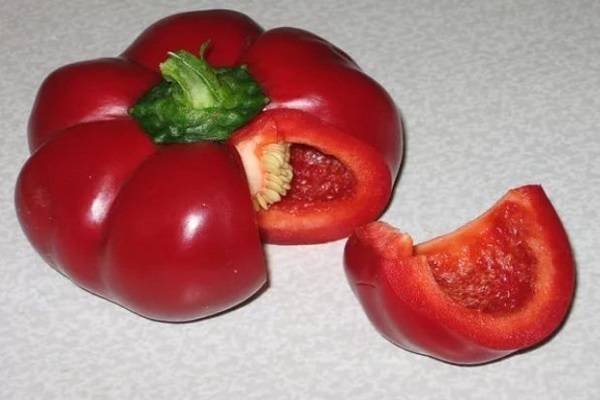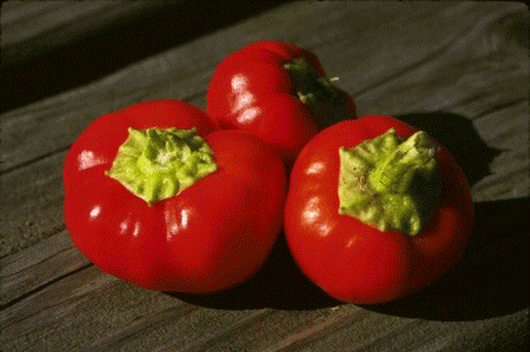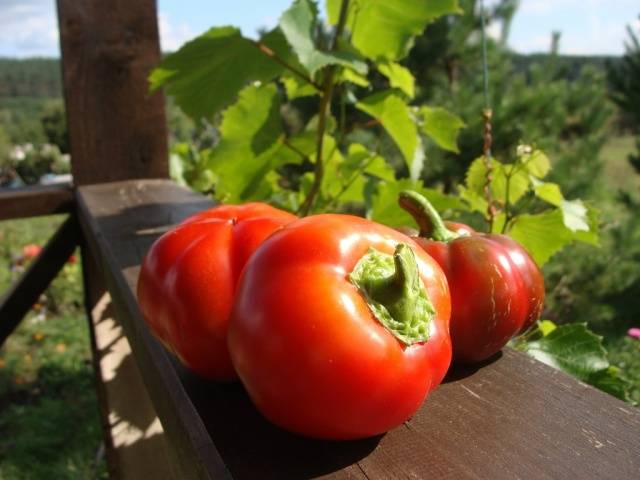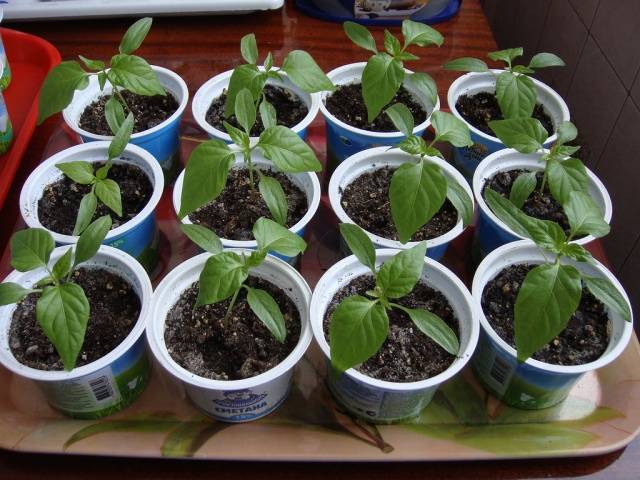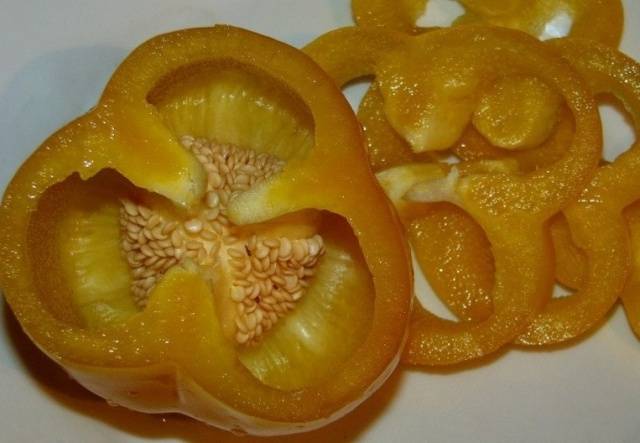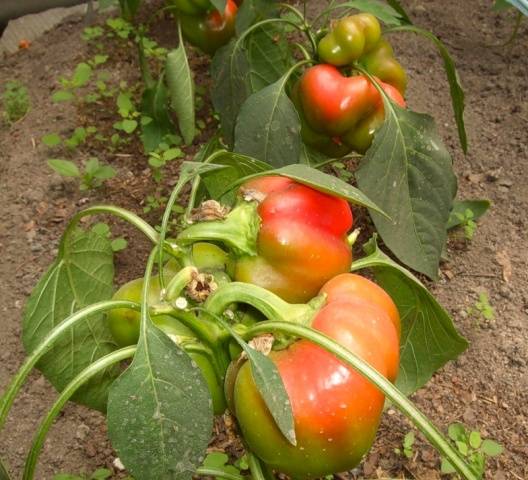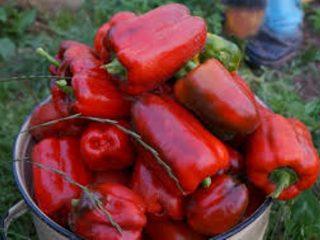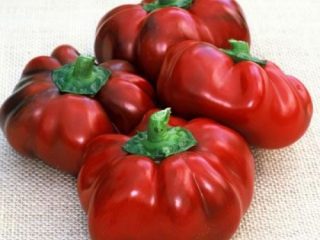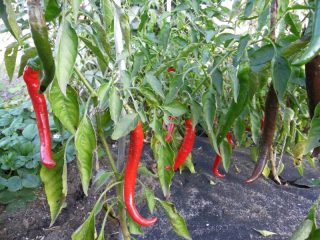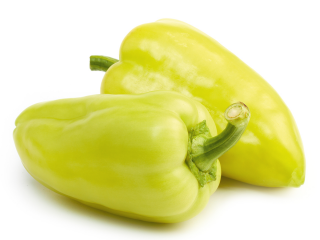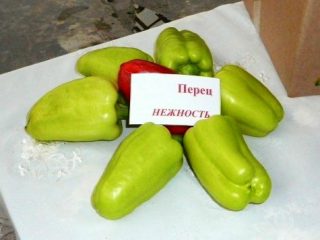Content
Among the many varieties and hybrids of sweet peppers, there is a special variety - Ratunda. Gardeners often call these round peppers, as if divided into slices, gogoshars. In the international classification, they are usually called “tomato pepper” - a tomato-shaped variety of pepper. There are many varieties of Ratunda peppers, they differ in color: red or yellow, shape and taste.
Characteristic
Ratunda sweet pepper is loved by vegetable growers for its excellent yield, dense structure, and resistance to fungal diseases. There are many varieties and hybrids of Ratunda pepper, bred in Moldova and Russia: Kolobok, Viscount, Merishor, Local Gogoshar, Rubiny 2, Sweet Candy, Olenka, Ruby Sweetness, Israeli Ratunda and others. In technical maturity, Ratunda is noticeable in a bright dark green color, in biological maturity – in rich dark red or bright yellow, like the Sun or Golden Jubilee.
Many varieties of Ratunda have fruits that look like miniature pumpkins with distinct segments, but there are also varieties with smooth, rounded barrels. A common feature of Ratunda sweet pepper pods is that they are not elongated, but flattened. The plant generates up to 12-15 pods. Up to 5 kg of fruits are collected from 1 square meter.
Ratunda pepper, according to the description of the varieties, mainly produces fruits without bitterness.Its peculiarity is that it is prone to cross-pollination. Close plantings of hot peppers will certainly affect the taste of any Ratunda variety, as well as most other varieties of sweet peppers. It should be noted that there are Ratunda varieties that are inherently bitter. But the pulp of the fruit is sweet; only the chamber partitions are hot. Then you get the semi-sharp taste of Ratunda fruits.
Ratunda pepper varieties are mid-ripening, up to 120-135 days, but there are also more early-ripening varieties. Ripe or even picked green fruits of Ratunda pepper are stored for a long time. Pepper can also be transported over long distances without damaging the appearance of the fruit.
Description
Ratunda bushes are standard, compact, low-growing, medium-leafy, quite powerful to withstand the fruit load. The plant does not rise above 35-60 cm. The leaves are medium in size, on long petioles. Flowers grow between the shoots.
The fruits of Ratunda pepper, as they are described in descriptions and reviews of vegetable growers, are large, round, flattened or with an elongated small tip. Unripe green, but suitable for eating in salads, as well as for stuffing and other dishes or preparations. Ripe fruits are cherry-colored or bright yellow, depending on the variety. Inside the Ratunda pepper pod there are several seed chambers where many seeds are located. The average fruit weight is 90-100 g. There are large-fruited varieties - up to 150-180 g.
Wall thickness from 6 to 10 mm. The partitions of some varieties of Ratunda are burning. The skin is thin, dense, with a waxy coating. The pulp is fleshy, juicy, crispy, and dense. The taste of Ratunda fruits is delicate, with a delicately expressed peppery smell.Possible spicy sharpness in taste sensations.
Advantages
The Ratunda pepper variety is popular due to its bright advantages.
- High yield;
- Excellent taste bouquet of fruits;
- Unpretentiousness of the plant;
- Resistance to Alternaria, tobacco mosaic virus, Verticillium wilt;
- Commercial attractiveness;
- Keeping quality and transportability of fruits.
Like all varieties of pepper, a southern crop, Ratunda requires careful care on fertile soils.
Growing
Ratunda is propagated by sowing seedlings. The seeds are sown in such a way that by the time they are planted in the greenhouse, the plants reach two months of age. Successful cultivation of Ratunda is possible on fertile soil.
Sowing
The best option for sweet peppers is to sow the seeds one at a time in pots, because the root system of the plant suffers during transplantation.
If the container for seedlings is homemade, you need to take care of the drainage system. First, holes are made in the bottom, and then a layer of middle fractions of agroperlite, crushed polystyrene foam from household appliance packaging, and broken ceramics is placed down. Be sure to have a tray where excess water will drain after watering.
Purchased soils need to be specialized, or pay attention to acidity. Ratunda prefers neutral or slightly alkaline soils (pH 7-7.2).
Seedling care
For good germination, containers are kept warm - up to 25 degrees. When sprouts appear, the daytime temperature initially remains at 18-20 degrees, then, after the first week, it rises to 25 0WITH.Night temperature should be reduced to 13-15 degrees so that the plants do not stretch and the root system is strengthened. Ratunda seedlings are provided with additional illumination for up to 14 hours. Use daylight ampoules or LED lamps. You can purchase special devices for lighting plants - phytolamps.
- The next important point in caring for sweet pepper seedlings is feeding. Purchase ready-made mixtures in stores and fertilize according to the instructions or prepare them yourself;
- The first feeding of plants is carried out in the phase of appearance of 1-2 true leaves. If sweet peppers need to be picked, the fertilizer is put aside for 10-12 days, after the replanting procedure. Dissolve a teaspoon of urea and a heaped tablespoon of superphosphate in 10 liters of water. Each plant is given 100-150 ml of solution;
- The second feeding of Ratunda is done a week before planting in a permanent place. Prepare a solution of two tablespoons of superphosphate and a tablespoon of potassium sulfate in 10 liters of water.
Pepper in a greenhouse
Sweet pepper Ratunda is planted when the first bud has already formed. Layout: 25 x 50 cm. Watering should be moderate, it is better to water more often, but not to over-moisten the soil. Plants need to be shaped.
- When the first branch is formed, all stepsons below it are removed;
- The first flower is picked;
- The weak one is removed from the next paired shoots, leaving the stronger one to grow;
- At the end of August, the tops of sweet peppers are pinched so that new shoots are not created and the plant directs its strength only to fruiting;
- The very first fruits are picked while still green to reduce stress on the plant. Cleaning is carried out after 5-10 days;
- Ripe pods are cut every week or, if necessary, more often.
You need to monitor the humidity level, especially during flowering. High humidity will interfere with pollination. When pollen falls, greenhouses are ventilated more often. Air flows contribute to the creation of ovaries. This process is very important for all types of pepper, since the number of seeds produced affects the size of the fruit. Hollow pods do not grow large.
Plant in the garden
Ratunda is planted in the southern regions at the end of May, early June, in the more northern regions later, when the threat of frost disappears. A fertile area, sufficiently illuminated, without drafts, located in a cozy place, protected from gusts of wind, is the best option for planting sweet peppers. In spring, the soil is fertilized: 35-40 g of phosphate and potassium compounds, 20-25 g of nitrogen.
- Peppers are watered with warm water, generously during the first week after planting, for better acclimatization of the plants;
- A good solution would be to mulch the soil so that moisture does not evaporate too quickly;
- Ratunda is fed with a mullein solution diluted in a ratio of 1:10, or with special complex fertilizers for peppers;
- Feeding peppers is required during the formation of buds, during flowering and fruiting;
- Removing the first flower encourages more fruit to form;
- During prolonged heat, above 35 degrees, Ratunda pepper plantings can be shaded using a net. Thanks to this method, plants avoid the stress of elevated temperatures and bear fruit better.
Plant protection
In greenhouse conditions, Ratunda pepper may suffer from aphids. Insects are controlled by applying foliar fertilizers containing potassium and phosphorus.
For other leaf-eating and soil pests, preparations based on biotoxins are used - Lepidocide, Fitoverm and others.
Savory fruits of an original shape will be a beautiful addition to the table, and in preparations they will remind you of the summer riot of nature.
